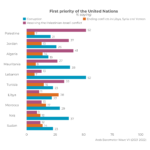- Arab Barometer’s sixth wave is the largest publicly available survey that captures the changing sentiments of citizens across MENA during the unprecedented times of the COVID-19 pandemic. Between July 2020 and April 2021, we interviewed 20,000 citizens in seven Arab countries, making ours the only survey of its kind to track changes in MENA citizens’ attitudes and behaviors over time during the pandemic.
- Nationally representative mobile phones surveys were fielded in Algeria, Tunisia, Libya, Morocco, Jordan, Lebanon and Iraq. Not all countries across the region were included due to funding limitations and feasibility considerations. At least 90% of citizens in each country surveyed have a mobile phone, permitting us to produce high-quality surveys.
- Wave VI is composed of three separate parts: Parts I and II were conducted in 2020 and each included six countries while Part III, which was conducted in 2021, included seven countries. Surveys in all Parts I, II, and III have approximately 1,000 respondents per country.
- Fielding mobile phone surveys permitted us to conduct research that was in compliance with local ordinances and social distancing protocols during the COVID-19 pandemic. This way of fielding differs from our long-standing face-to-face approach, but ensured the health and safety of our interviewers, the respondents, and their communities.
- In Lebanon, the phone numbers were called randomly from a list of more than 350,000 numbers stratified by governorate and sect. In all other countries, samples were generated by using random-digit dialing (RDD).
- Phone surveys are typically shorter than face-to-face surveys because respondents are unwilling to remain engaged for the same length of time. Accordingly, in most countries we conducted multiple surveys during this wave to allow us to cover more topics of interest. The surveys in Parts I, II, and III each lasted approximately 25 minutes.
- Most questions were closed-ended, meaning respondents picked the response option that most closely matched their view.
Technical Reports
Participating Institutions
- Algeria: One to One for Research and Polling
- Jordan: Center for Strategic Studies (Walid al-Khateeb)
- Iraq: Independent Institute for Administration and Civil Society Studies (IIACSS) (Arwa Daghir)
- Lebanon: Statistics Lebanon Ltd. Polling and Research (Rabih Habr)
- Moroccco: One to One for Research and Polling
- Libya: One to One for Research and Polling
- Tunisia: One to One for Research and Polling (Imen Mezlini)


